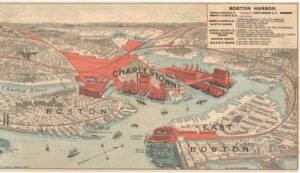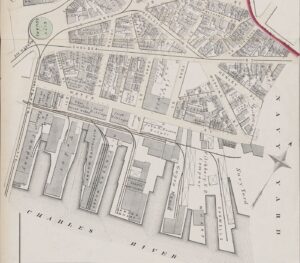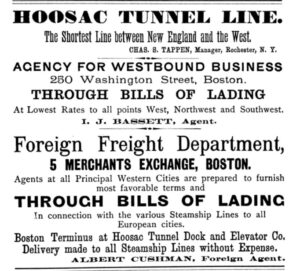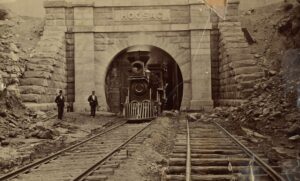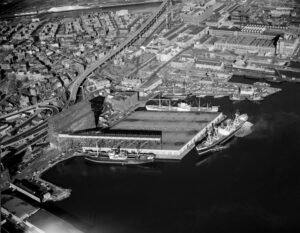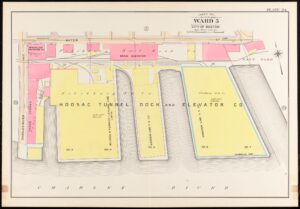Overseas Via Hoosac Tunnel Docks
in Charlestown
The 1900 map, though not to scale, shows the Boston & Maine Railroad’s integral role in Boston’s sea trade. About half of the city’s foreign trade at the time took place here at Hoosac Tunnel Docks.
Boston & Maine Railroad
When the Hoosac Tunnel was completed in northwestern Massachusetts in 1875, it transformed Boston Harbor’s foreign trade for decades. The tunnel connected the Fitchburg Railroad terminal here on Charlestown’s waterfront to the country’s heartland more than a thousand miles away. Huge shipments of grain and livestock could be transported by rail to the newly named Hoosac Tunnel Docks and then by steamship around the world.
In the 1880s, Hoosac Tunnel Dock and Elevator Company enlarged the wharves, built a grain elevator, sheds, and warehouses. Between 1870 and 1900, Boston’s exports grew from $14 million to $124 million. When the Boston & Maine Railroad took over the Fitchburg Railroad in 1900, Hoosac Tunnel Docks’ reach expanded further.
Boston’s longstanding position as second busiest port in the country ended soon thereafter, however, largely for reasons beyond the city’s control. A 1940s dock and grain elevator renovation briefly revitalized the facility, but it was too small for larger cargo ships. In the late 1900s, the mighty Hoosac Tunnel Docks—renamed Constitution Wharf—began a new life as office buildings and condominiums.
Sign Location
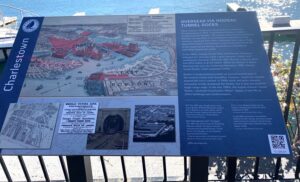
More …
Resources
- Boston & Maine Railroad Historical Society
- Bunting, W. H. Portrait of a Port: 1852-1914. The Belknap Press of Harvard University Press, 1971.
- Weinbaum, Paul, O. “Hoosac Docks: Foreign Trade Terminal, A Case of the Expanding Transportation System Late in the Nineteenth Century,” A Special History Study. Boston National Historical Park, 1985.
- Bromley 1901 Atlas link https://collections.leventhalmap.org/search/commonwealth:tt44pw17f
Acknowledgments
- Our gratitude to the Perkins School for the Blind and Thomasine Berg for their partnership in creating the audio files.

